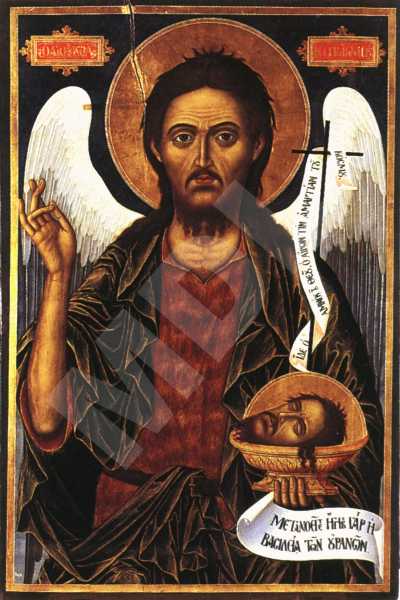St. John the Forerunner
Type:
Icon
Period:
1848 year
Dimiter T. Molerov, born in 1780 in Bansko, son of Toma Vishanov the Moler. One of the best-known painters, a representative of the Bansko school of art, a disciple of his father, influenced by the art of Athos. Author of the murals of the naos in the St Archangels' paraclete in the Rila monastery, the murals in the Church of the Assumption of the Virgin in the Pchelino dependance. In 1840 and 1841 together with his son Simeon Molerov he paints the murals and the sponsors' portraits in St. Nicholas' and St. John of Rila's paracletes in the principal church in the Rila monastery. Among D. Molerov's major achievements in iconography are the following icons: St. Nicholas (1816) from St. Archangel Michael's church in the village of Leshko, Christ All-triumphant with Angels and Cherubim (1833), The Nativity and a Crucifixion from St Elijah the Prophet's church in the village of Usenovo. He has also worked in Belgrade on an invitation by Prince Milosh Obrenovich of Serbia. He died in 1870 in Bansko.
Dimmensions (cm):
113
/ 75
/ 3.5
Location
Country: Bulgaria
Province: Blagoevgrad
Village: Teshevo
Church: St. Demetrius
Source
Country: Bulgaria
Province: Blagoevgrad
Village: Teshevo
Church: St. Demetrius
Description
A traditional compositional treatment of the theme.
Iconographical technique: Combined
Egg-and-oil, with velaturas and gilding. There are on the brown frame insignificant damages, especially in its upper part. The varnish cover is laid unevenly; there are on flowings of golden-brown varnish. There are wide-open and deep crackings in the varnish cover.
Base material: Wood
The base is a walnut panel with an adhering to it a second narrow panel, nailed onto it with iron nails. The panel is hand-made. The icon's back is reinforced in its upper and lower ends by means of two softwood beams. The ground coat is of plaster, laid in a thin layer, relatively unimpaired and well-preserved.
State, restoration traces and comments
The soundings, which have been carried out, have localized the existence of secondary covers over the two denotative inscriptions of St. John the Forerunner up above with a dark red paint and white letters, the band around the cross is covered entirely with white paint and black letters; down below on the roll as well. The crack is filled up with wax and a retouching had been made, which is to be seen on the borders of the original. After that late intervention, a new varnish cover had been laid on the icon.
In the icon lower left corner we can decipher the year when it had been painted: 1848.


